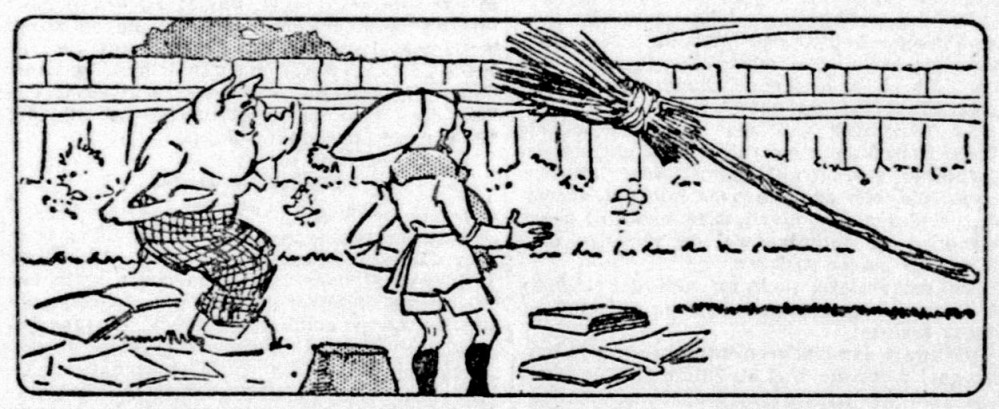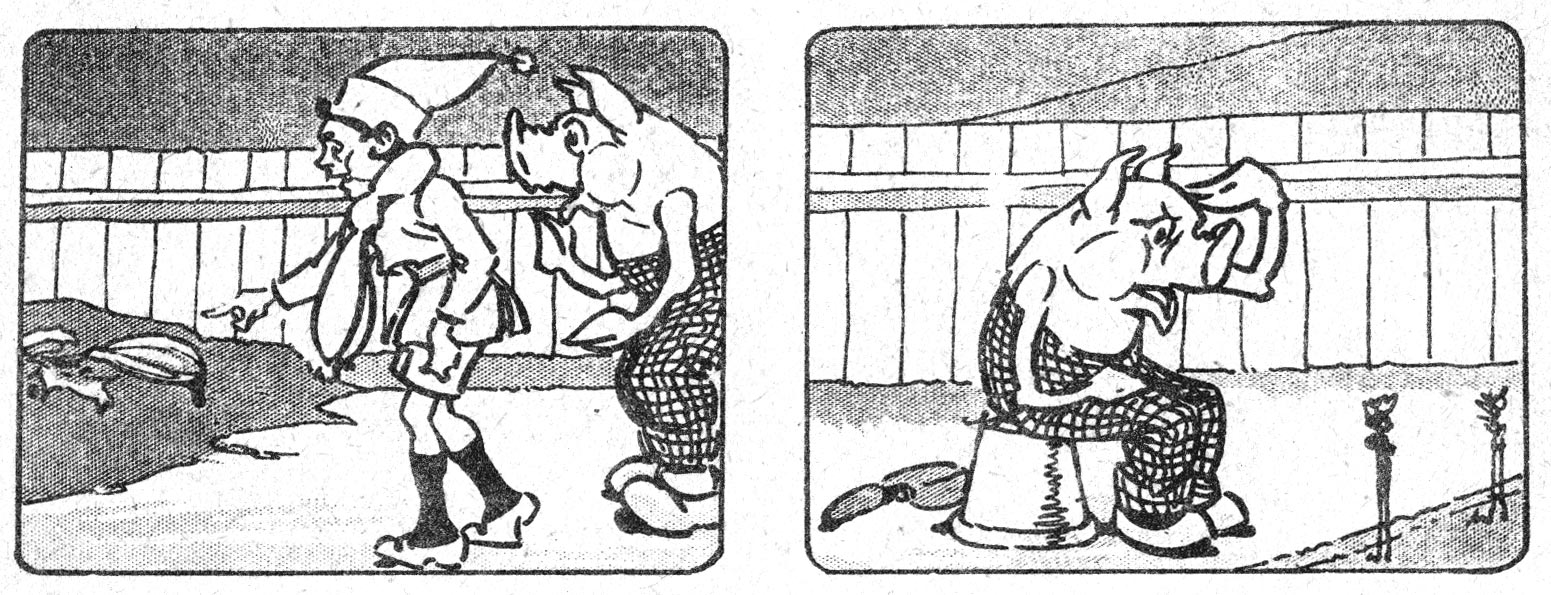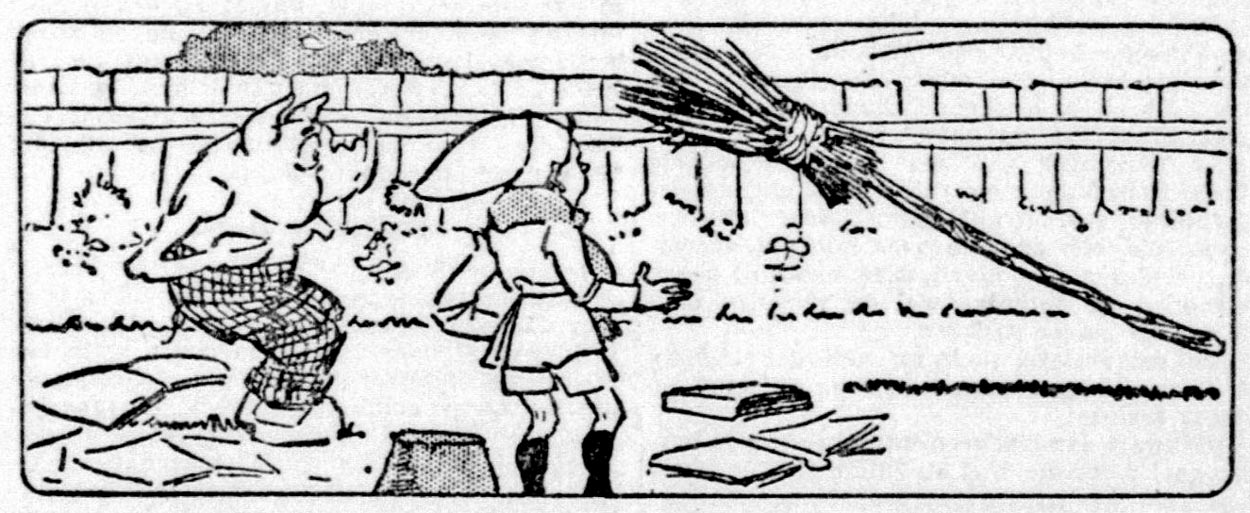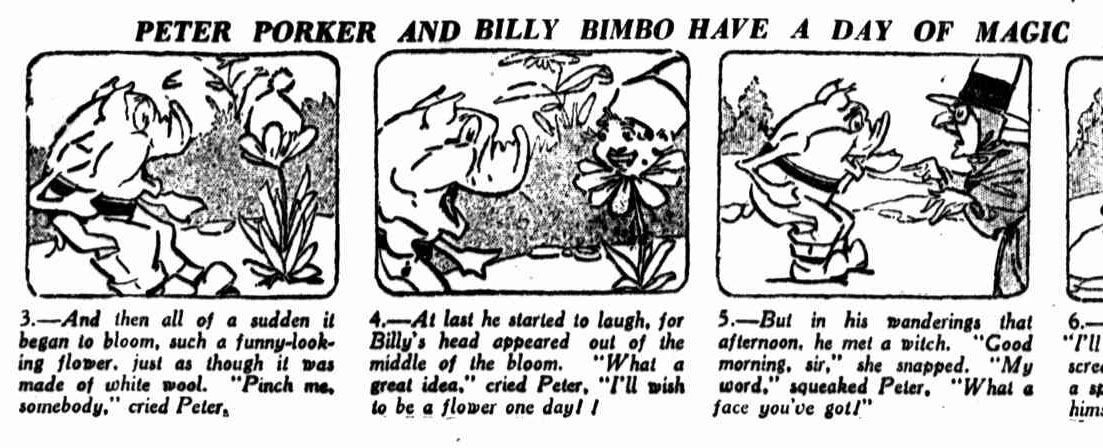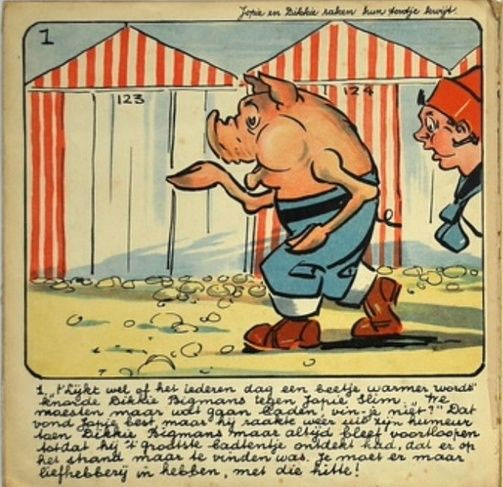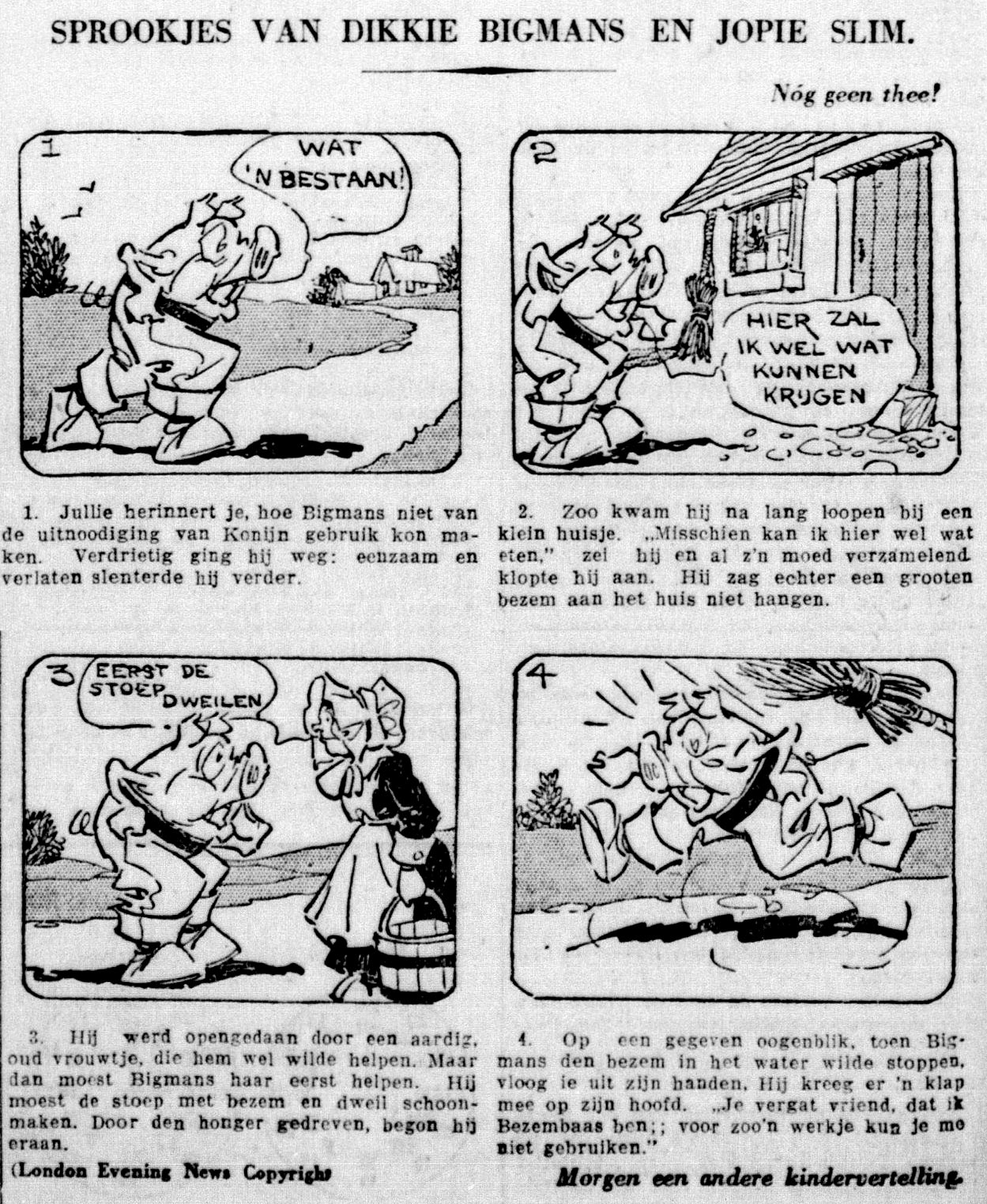'Billy Bimbo and Peter Porker'.
Harry Folkard is an early-20th century British cartoonist, and most likely the artist of the 1920s newspaper comic strip 'Billy Bimbo and Peter Porker' (1920-1925), drawn for the London Evening News. The series featured the adventures of a young boy and an anthropomorphic pig. It was a remarkable success in The Netherlands at the time, where it ran under the translated title 'Jopie Slim and Dikkie Bigmans'. During the 1930s, Folkard was also the second artist to draw 'Teddy Tail', a funny animal comic series for the Daily Mail, created by his brother Charles James Folkard.
Family
It is unknown where or when Harry Francois Folkard was born, but presumably around the turn of the 20th century. His place of birth was likely near London, since his younger brother, illustrator and cartoonist Charles James Folkard, lived there.
'Billy Bimbo and Peter Porker'.
Billy Bimbo and Peter Porker
Like his brother, Harry Folkard worked as a cartoonist as well. He was presumably the author of the humorous comic strip 'Billy Bimbo and Peter Porker' (1920-1925), a series published in the London Evening News. The feature stars a young boy with a gnome-like cap, called Billy, and an anthropomorphic pig wearing plaid pants, Peter Porker. Many gags feature the duo playing pranks on their environment and their subsequent punishments. Like many British newspaper picture stories of the time, the series was presented in the text comic format, with captions underneath the images. In the United Kingdom, 'Billy Bimbo and Peter Porker' were featured on a 1922 LP with bedtime stories for children, produced by The Gramophone Company Ltd. and narrated by Australian-British music hall singer Albert Whelan.
'Peter Porker and Billy Bimbo' in The Sydney Sun (19 March 1922).
Billy Bimbo and Peter Porker: foreign success
While Billy Bimbo and Peter Porker did well in their country of origin, the characters became a surprising success abroad. In Australia, 'Billy Bimbo and Peter Porker' ran in The Sun, a tabloid newspaper published in Sydney. 'Billy Bimbo' was also one of the first comic features to appear in a Dutch newspaper. On 24 July 1921, the strip was published in the Dutch newspaper De Telegraaf under the title 'Jopie Slim en Dikkie Bigmans'. Quickly becoming a readers' favorite, it inspired an astonishing line of merchandise, including picture books, statues, pins, calendars and charms. Between 1922 and 1927, several booklets compiling episodes from the Telegraaf serializations were released. The first was 'Jopie Slim en Dikkie Bigmans Aan Het Strand' (1922), published in both square and landscape format by De Blauwvoet v/h Nuss & Voskuyl in Baarn. The landscape format edition was a promotional booklet for the Dutch chocolate factory Van der Woude & Dekker in Zaandijk. In 1925, publisher Kluitman in Alkmaar then released another series of books, consisting of 'Het Grappige Hert', 'De Boksende Kangoeroe', 'De Apenkooi' and 'De Reuzenpaddestoel'. In that same year, Emrik & Binger from Haarlem released a children's coloring book with the characters under the title 'Jopie Slim & Dikke Bigmans in hun tuintje'. Two years later, this title was released in another edition as an advertising publication for jam factory De Betuwe.
From the Dutch booklet 'Jopie Slim en Dikkie Bigmans Aan Het Strand'.
From 1921 until the early World War II years, stage shows based on 'Jopie Slim en Dikkie Bigmans' were performed in Amsterdam, Rotterdam and The Hague, with Corry Vonk as Jopie Slim. Composer Max Tak created a popular novelty song, performed by The Silver Stars Band ('Jopie Slim en Dikkie Bigmans zijn de Schrik van 't Ganse Land'), which was re-recorded in 1983 by singer Tek Houkes. In 1938, a low-budget Dutch children's film with the characters was made by Jan van Dommelen, 'De Guitenstreken van Jopie Slim and Dikkie Bigmans'. De Telegraaf published 'Jopie Slim en Dikkie Bigmans' until their final episode appeared in print on 19 November 1925.
In the Netherlands, 'Jopie Slim en Dikkie Bigmans' was the first genuine commercial hit comic series. Following the success, newspaper De Telegraaf soon started offering space to more comics, while other Dutch newspapers did the same. At the time, the comic was so well known that A.M. de Jong and George van Raemdonck spoofed the duo in their own series 'Bulletje en Boonestaak', which ran in the competing newspaper Het Volk. In one memorable 1922 episode, Bulletje and Boonestaak visit the office of the London Evening News to beat up Billy and Peter, because "these two English monstrosities had bored Dutch children quite enough with their whining."
Teddy Tail
Perhaps even unaware of his overseas success, Harry Folkard in the meantime took over the famous comic strip 'Teddy Tail', created between 1915 and 1926 by his brother Charles James Folkard, who left the strip to concentrate on his career as an illustrator. Running in the Daily Mail, 'Teddy Tail' was a comic about the fantasy adventures of a little mouse with a knot in its tail. When his brother was in the army during World War I, Harry Folkard had taken over the feature for the first time. On 8 April 1933, Harry Folkard revived the feature in a full-page adventure story in which the mouse was domesticated and became a schoolboy character in the Daily Mail's color supplement Boys & Girls Daily Mail. From November of that same year, this color page was continued by Herbert Sidney Foxwell. Harry Folkard's art also decorated the original badge of the Teddy Tail League, the character's official fanclub, launched in 1933.
Other illustration work
Harry Folkard's art additionally appeared in British comic papers and magazines like the Sunday Dispatch supplement Jolly Jack's Weekly ('Jolly Jack's Fun Ship', 1933), Sparkler of the Amalgamated Press ('Blooka and the Rubberbeak', 1935) and C. Arthur Pearson's The Summer Comic ('Prisoners in the Cavern', 1936).
Death and legacy
Just like his date of birth, Harry Folkard's death date is unknown. He presumably passed away somewhere in the mid-20th century. Folkard's contribution to his own country's comics history may have been minimal, but he did have a considerable impact on Dutch comics culture. Not only because of the popularity of his own 'Billy Bimbo and Peter Porker', but also because in the decades after Folkard's series first appearance, several Dutch newspapers and magazines began running translated British comics. Many of them enjoyed an equal amount of popularity, such as Mary Tourtel's 'Rupert Bear' ('Bruintje Beer' in Dutch), Les Barton's 'Billy Bunter' ('Billie Turf'), John Gillatt's 'Billy's Boots' ('De Wondersloffen van Sjakie'), E.George Cowan and Ted Kearon's 'Robot Archie' ('Archie, De Man van Staal'), Frank S. Pepper and Joe Colquhoun's 'Roy of the Rovers' ('Rob van de Rovers') and Mike Butterworth and Don Lawrence's 'The Trigan Empire' ('Trigië') . Some magazines, like the girls' magazine Tina, ran a great many stories from British magazines like Princess Tina.
Jopie Slim en Dikkie Bigmans, from Dutch newspaper De Telegraaf, 11 April 1925. The drawing style seems to have changed considerably, so perhaps there was another artist on the job.


